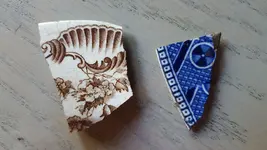The fragment on the left is what I commonly refer to as 'Victorian Transferware' porcelain, likely made in England from 1840 - 60.
"Transfer printing is a method of decorating pottery or othermaterials using an engraved copper or steel plate from which a monochrome printon paper is taken which is then transferred by pressing onto the ceramic piece.Pottery decorated using the technique is known as transferware. It was developed in England from the 1750s on, and in the 19th century became enormously popular in England, though relatively little used in other major pottery-producing countries. The bulk of production was from the dominant Staffordshire pottery industry. America was a major market for English transfer-printed wares, whose imagery was adapted to the American market; several makers made this almost exclusively."
The 'blue' fragment on the right is typically called 'Flow Blue' porcelain. c1840
"Flow blue is a style of white earthenware, sometimes porcelain, that originated in the Regency era, sometime in the 1820s, among the Staffordshire potters of England. The name is derived from the blue glaze thatblurred or "flowed" during the firing process. Most flow blue ware is a kind of transferware, where the decorative patterns were applied with a paper stencil to often white-glazed blanks, or standard pottery shapes, though some wares were hand painted. The stencils burned away in the kiln. The blue glazes used in flow blue range from gray-blue to sometimes greenish blue, to an inky blue; however, the most desirable and sought-after shade is a vivid cobalt blue. Mulberry is another form of flow blue, where the glaze is more purple in colour."




